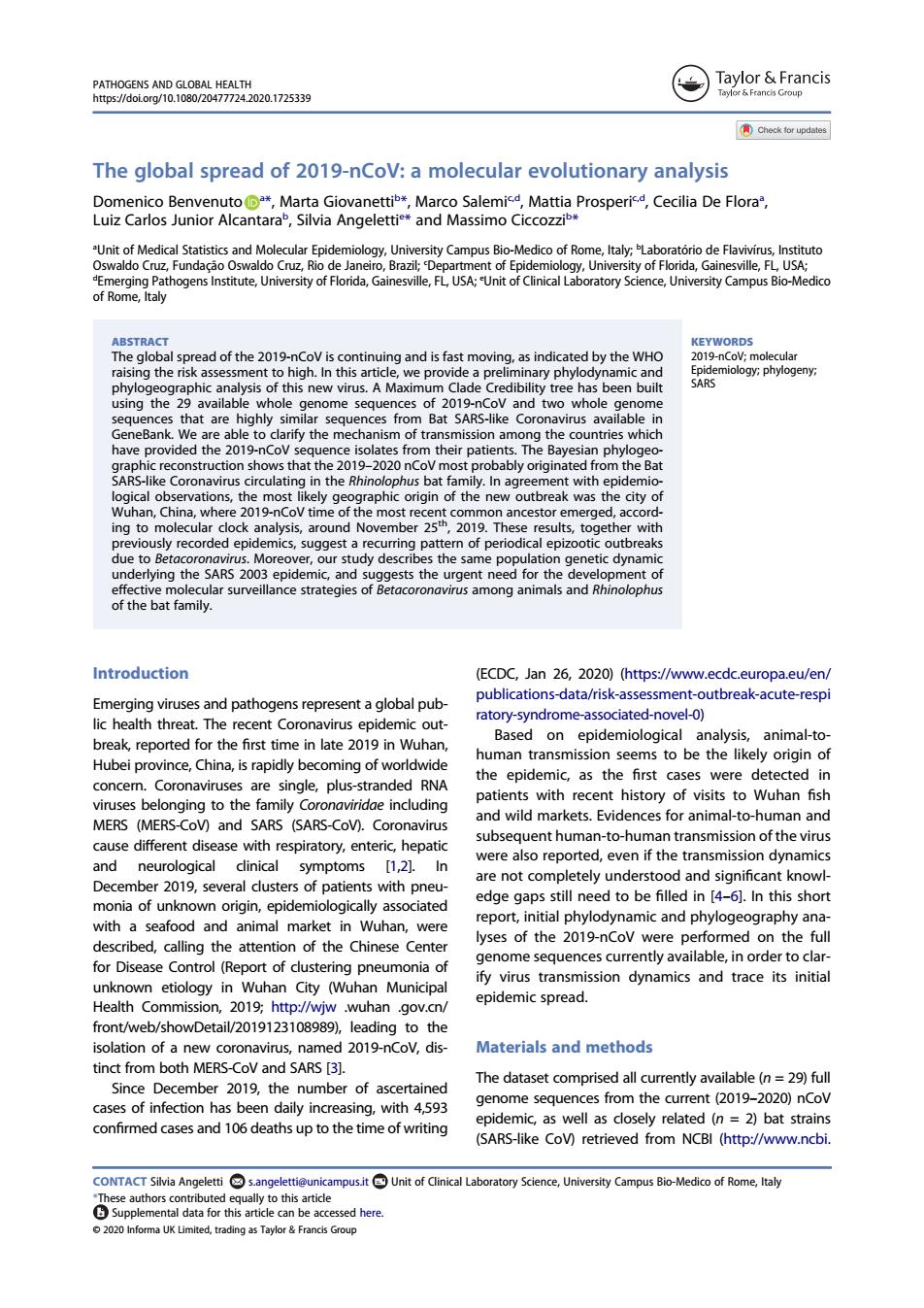正在加载图片...

PA9950A402a172533 ©Taylor&Francis The global spread of 2019-nCoV:a molecular evolutionary analysis and Mo s Bio-Medico of Ror 2019wD5 are ni ence the ne mics,su enetic dyna ing the SARS of the bat family. Introduction ator-s mdrome associated-novel-o) break,reported for the first time in late 2019 in Wuhan, Based on epidemioloaical analysis animal-to Hubei pr ce,China,is rapidly b ecoming of worldv human transmission seems to be the likely origin of plus-strand epide IC,as recent subsequent human-to-human transmission of the viru cause different dise e with respiratory,enteric,hepatic and neurological dinical symptoms 1,2 were also reported,even if the transmission dynamic December 219,several cust are not completely unde nts with pe stood and significant knov to be d in 5].In this shor of the e ful bed callina the attention of the chinese center for Disease Control (Report of dustering pneumonia of enome sequences currently available.in order to clar fy virus transmission dynamics and trace its initia own etiology in Wuhan City (Wuhan Municipal epidemic spread. D2D01912310 9)wuh ation of a named 2019-nCoV.dis Materials and methods tinct from both MERS-CoV and SARS) Since The dataset comprised all currently available (n=29)full December 2019,the number of ascertain of ction me sequences from the current (2019- 2020n0 aily increasing,w as cases and ths up to the time o wnting well as cl 2)bat stra ed here na UK Limited.trading as Taylor Francis Group The global spread of 2019-nCoV: a molecular evolutionary analysis Domenico Benvenuto a *, Marta Giovanettib *, Marco Salemic,d, Mattia Prosperic,d, Cecilia De Floraa , Luiz Carlos Junior Alcantarab , Silvia Angelettie * and Massimo Ciccozzib * a Unit of Medical Statistics and Molecular Epidemiology, University Campus Bio-Medico of Rome, Italy; b Laboratório de Flavivírus, Instituto Oswaldo Cruz, Fundação Oswaldo Cruz, Rio de Janeiro, Brazil; c Department of Epidemiology, University of Florida, Gainesville, FL, USA; d Emerging Pathogens Institute, University of Florida, Gainesville, FL, USA; e Unit of Clinical Laboratory Science, University Campus Bio-Medico of Rome, Italy ABSTRACT The global spread of the 2019-nCoV is continuing and is fast moving, as indicated by the WHO raising the risk assessment to high. In this article, we provide a preliminary phylodynamic and phylogeographic analysis of this new virus. A Maximum Clade Credibility tree has been built using the 29 available whole genome sequences of 2019-nCoV and two whole genome sequences that are highly similar sequences from Bat SARS-like Coronavirus available in GeneBank. We are able to clarify the mechanism of transmission among the countries which have provided the 2019-nCoV sequence isolates from their patients. The Bayesian phylogeographic reconstruction shows that the 2019–2020 nCoV most probably originated from the Bat SARS-like Coronavirus circulating in the Rhinolophus bat family. In agreement with epidemiological observations, the most likely geographic origin of the new outbreak was the city of Wuhan, China, where 2019-nCoV time of the most recent common ancestor emerged, according to molecular clock analysis, around November 25th, 2019. These results, together with previously recorded epidemics, suggest a recurring pattern of periodical epizootic outbreaks due to Betacoronavirus. Moreover, our study describes the same population genetic dynamic underlying the SARS 2003 epidemic, and suggests the urgent need for the development of effective molecular surveillance strategies of Betacoronavirus among animals and Rhinolophus of the bat family. KEYWORDS 2019-nCoV; molecular Epidemiology; phylogeny; SARS Introduction Emerging viruses and pathogens represent a global public health threat. The recent Coronavirus epidemic outbreak, reported for the first time in late 2019 in Wuhan, Hubei province, China, is rapidly becoming of worldwide concern. Coronaviruses are single, plus-stranded RNA viruses belonging to the family Coronaviridae including MERS (MERS-CoV) and SARS (SARS-CoV). Coronavirus cause different disease with respiratory, enteric, hepatic and neurological clinical symptoms [1,2]. In December 2019, several clusters of patients with pneumonia of unknown origin, epidemiologically associated with a seafood and animal market in Wuhan, were described, calling the attention of the Chinese Center for Disease Control (Report of clustering pneumonia of unknown etiology in Wuhan City (Wuhan Municipal Health Commission, 2019; http://wjw .wuhan .gov.cn/ front/web/showDetail/2019123108989), leading to the isolation of a new coronavirus, named 2019-nCoV, distinct from both MERS-CoV and SARS [3]. Since December 2019, the number of ascertained cases of infection has been daily increasing, with 4,593 confirmed cases and 106 deaths up to the time of writing (ECDC, Jan 26, 2020) (https://www.ecdc.europa.eu/en/ publications-data/risk-assessment-outbreak-acute-respi ratory-syndrome-associated-novel-0) Based on epidemiological analysis, animal-tohuman transmission seems to be the likely origin of the epidemic, as the first cases were detected in patients with recent history of visits to Wuhan fish and wild markets. Evidences for animal-to-human and subsequent human-to-human transmission of the virus were also reported, even if the transmission dynamics are not completely understood and significant knowledge gaps still need to be filled in [4–6]. In this short report, initial phylodynamic and phylogeography analyses of the 2019-nCoV were performed on the full genome sequences currently available, in order to clarify virus transmission dynamics and trace its initial epidemic spread. Materials and methods The dataset comprised all currently available (n = 29) full genome sequences from the current (2019–2020) nCoV epidemic, as well as closely related (n = 2) bat strains (SARS-like CoV) retrieved from NCBI (http://www.ncbi. CONTACT Silvia Angeletti s.angeletti@unicampus.it Unit of Clinical Laboratory Science, University Campus Bio-Medico of Rome, Italy *These authors contributed equally to this article Supplemental data for this article can be accessed here. PATHOGENS AND GLOBAL HEALTH https://doi.org/10.1080/20477724.2020.1725339 © 2020 Informa UK Limited, trading as Taylor & Francis Group